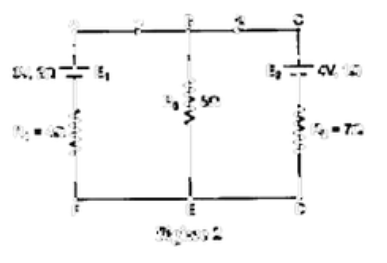Kirchhoff's first and second laws for electrical circuits are consequences of:-
Conservation of energy
Conservation of electric charge and energy respectively
Conservation of electric charge
Conservation of energy and electric charge respectively
The correct Answer is:B
To solve the question regarding Kirchhoff's first and second laws for electrical circuits, we need to understand what these laws state and what fundamental principles they are based on.
1. Understanding Kirchhoff's First Law (KCL):
- Kirchhoff's First Law, also known as the Current Law (KCL), states that the total current entering a junction (or node) in an electrical circuit must equal the total current leaving that junction. This can be expressed mathematically as:
Iin=Iout
- This law is based on the principle of conservation of electric charge, which states that charge cannot be created or destroyed.
2. Understanding Kirchhoff's Second Law (KVL):
- Kirchhoff's Second Law, known as the Voltage Law (KVL), states that the sum of the electrical potential differences (voltage) around any closed loop in a circuit must equal zero. This can be expressed as:
∑V=0
- This law is based on the principle of conservation of energy, which states that energy cannot be created or destroyed, only converted from one form to another.
3. Conclusion:
- Therefore, Kirchhoff's first and second laws are consequences of the conservation of electric charge and conservation of energy, respectively.
4. Final Answer:
- The correct option that states Kirchhoff's laws are consequences of conservation principles is Option B: Conservation of charge and energy.
- Kirchhoff's First Law, also known as the Current Law (KCL), states that the total current entering a junction (or node) in an electrical circuit must equal the total current leaving that junction. This can be expressed mathematically as:
Iin=Iout
- This law is based on the principle of conservation of electric charge, which states that charge cannot be created or destroyed.
- Kirchhoff's Second Law, known as the Voltage Law (KVL), states that the sum of the electrical potential differences (voltage) around any closed loop in a circuit must equal zero. This can be expressed as:
∑V=0
- This law is based on the principle of conservation of energy, which states that energy cannot be created or destroyed, only converted from one form to another.
- Therefore, Kirchhoff's first and second laws are consequences of the conservation of electric charge and conservation of energy, respectively.
- The correct option that states Kirchhoff's laws are consequences of conservation principles is Option B: Conservation of charge and energy.
Similar Questions
Knowledge Check
- Question 1 - Select One
Kepler's second law is a consequenc of
Aconservation of energyBconservation of linear momentumCconservation of angular momentumDconservation of mass
What does an electric circuit mean ?
View SolutionThe second law of mendel is
View SolutionFuse is connected in an electric circuit.
View SolutionOn which conservation principle is Kirchhoff.s second law of electrical networks based ?
View SolutionE1andE2 are two batteries having emfs of 3V and 4V and internal resistances of 2Ωand1Ω respectively. They are connected as shown in Figure 2 below. Using Kirchhoff.s Laws of electrical circuits, calculate the currents I1andI2.
 View Solution
View SolutionA switch is an on-off device in an electric circuit.
View SolutionKirchhoff's current law is the law of conservation of
View Solution

